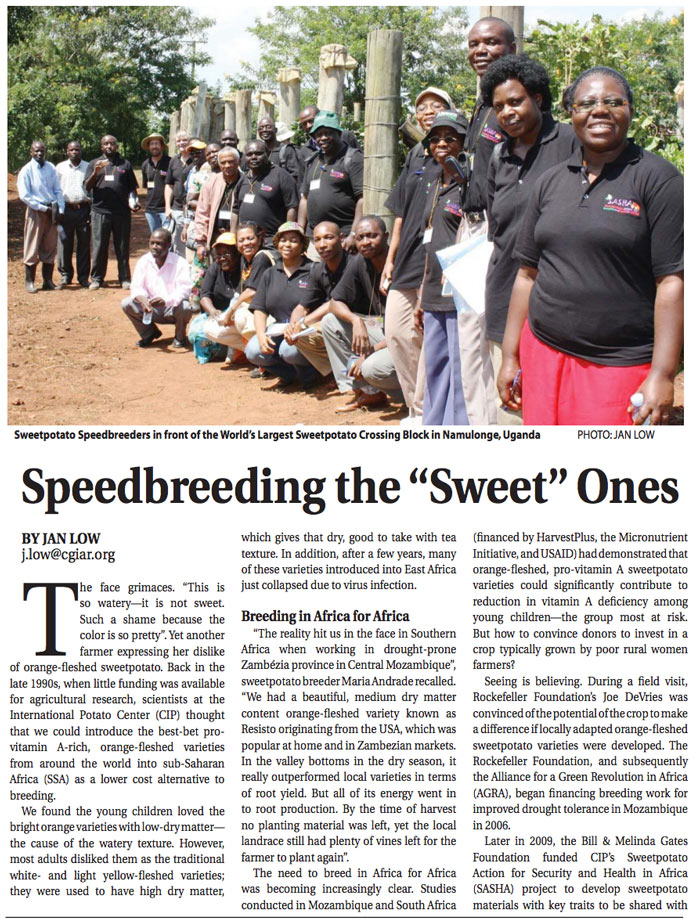<!– The March edition of the popular Hortinews magazine is focused on all things sweetpotato!
Titled ‘The Sweetpotato Transformation’ the edition incorporates articles and material from a wide range of research centers, ngo’s and private sector companies working with sweetpotato in sub-Saharan Africa.
–>
Visit Hortinews to read the articles online or go directly to this link to download the Sweetpotato Transformation edition. Happy reading!

Please feel free to share your comments or questions about what you read with the International Potato Center via our CIP Facebook page or take a look at the CIP website for more information on our sweetpotato and potato programs in SSA and globally. Take a look at the articles below to see what sparks your interest! Or download the entire Sweetpotato Transformation edition here.
Shaping up the orange fleshed sweetpotato – A great article all about Shamba Shape Up an educational TV show which featured OFSP and CIP during the 2014 season. The 8 episodes featured stories on planting, disease, storage, vine health and cooking on citizen TV. Read the article for more fun details about the show!
Scaling up sweetpotato through agriculture and nutrition – SUSTAIN is a 5-year regional project (2013-2018) aimed at enhancing the nutritional security of women and young children in East and Southern Africa through integrated agriculture-nutrition-market interventions using pro-vitamin A rich orange-fleshed sweetpotato (OFSP).

Sweetpotato is the third most important food crop in terms of production in East Africa and the fourth most important food crop in Southern Africa. Yet sweetpotato rarely gets the attention it deserves as a food security and nutrition powerhouse. In part, this is due to the widespread perception that it is a poor person’s food instead of recognizing that it is a health food for all persons that can be grown widely throughout Sub-Saharan Africa. Read more here: Enhancing the lives of 10 million African families in 10 years.
A great blog from Dr Jan Low, leader of the Sweetpotato for Profit and Health Initiative – titled Speedbreeding the “Sweet” Ones. This article originally appeared on the #CGIAR_DD “Talking Science” blog competition for CGIAR and Partner scientists.

Development of the sweet potato in Sub-Saharan Africa would not be complete without a facility to conduct food chemistry and nutritional analysis. Towards this end, a suitable nutrition laboratory with the necessary equipment is being established at the ILRI campus in Nairobi, Kenya. It is important to understand and therefore constructively manage the many factors that can affect pro-vitamin A concentrations: cultivar differences and the effects of production practices, growing location, harvest maturity and postharvest handling and processing. The required analysis is complex, needs careful sampling, controls and sample storage. Read more about this issue here: Nutritional analysis is critical to the development of OFSP in SSA.

Integrated health and agriculture to maximize the nutritional impact of orange fleshed sweetpotato highlights the Mama Sasha proof-of-concept project in Western Kenya. The project encouraged pregnant women to get the health care they need and increase consumption of provitamin A-rich orange-fleshed sweetpotato, a nutritional powerhouse that holds promise for reducing under-nutrition and combating vitamin A deficiency in sub-Saharan Africa.
In the early 2000s the Osamba family of Semenya Village, Ugunja Sub-County in Kenya had their lives changed after becoming successful small-scale orange-fleshed sweetpotato (OFSP) seed multipliers – A shining investment for smallholder farmers in Ugunja and Gem sub-counties in Kenya An interesting learning case developed under the project “Scaling up Technologies in Orange Fleshed Sweetpotato using the Agricultural Innovation System (AIS) to Address Food and Nutrition Security in Eastern and Central Africa”.

There are also a range of articles from other organisations and individuals working in the field of sweetpotato including ‘Capacity building to expand sweetpotato production and markets’ from the USAID Kenya Horticulture Competitiveness Project (KHCP) and a fantastic interview with Dr Laura Karanja Plant Virologist, Breeder and Principal Research Officer at Kenya Agricultural and Livestock Research organization (KALRO) titled ‘Addressing sweetpotato challenges through research’.
Enjoy. And happy reading!
